Use the following link to download the April 27, 2024 issue of the syəcəb
Author: Kim Kalliber
Art Festival empowers youth artists
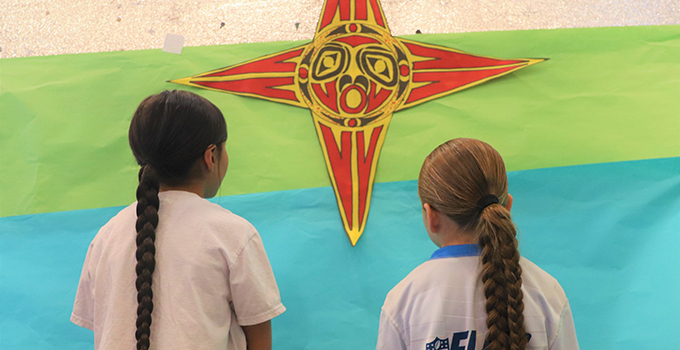
By Micheal Rios, Tulalip News
Creatively inclined Native American students of the Marysville School District wandered through a makeshift art gala that was the Don Hatch Youth Complex on Thursday, April 18 for an always eye-captivating Art Festival. Accompanied by their families, friends and educators, emerging artists ranging from 1st to 12th grade wowed Festival visitors and judges with a variety of imaginative creations that centered around a shared Tulalip culture expressed via a variety of modern-day mediums.
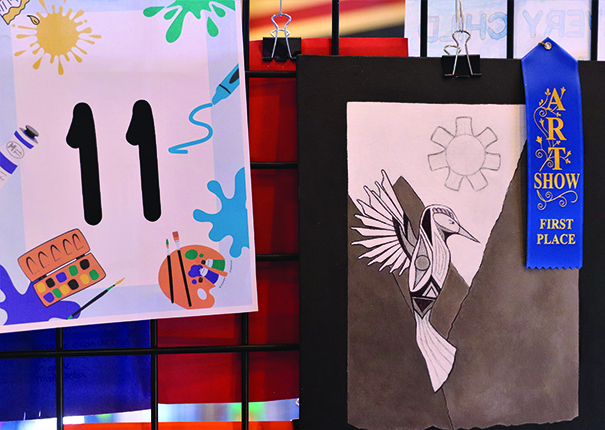
“Our annual Art Festival is an opportunity for each Native student within the District to express themselves in a unique and creative way,” explained positive youth development lead advocate, Deyamonta Diaz. “All the work that goes on behind the scenes to make this event possible, it’s like an all-hands-on-deck effort, is so worth it for our community to witness the pride and joy every student puts into their art.
“Each year our expectations are surpassed because we receive hundreds and hundreds of submissions,” he added. “For me, I look forward to seeing what new ways our kids find to express their Native culture or even developing their own way to retell a traditional story. There’s always something new and eye-catching that they come up with.”
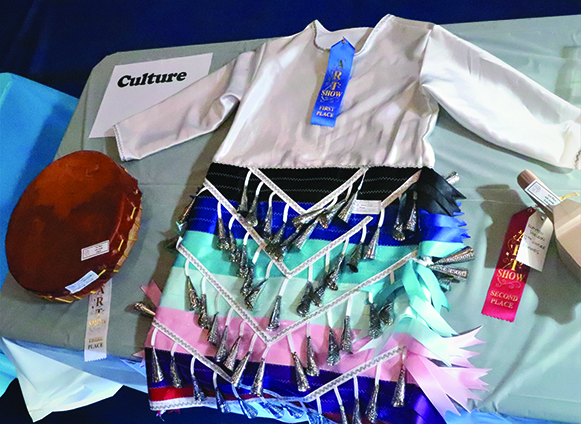
For more than two decades now, Tulalip Tribes has partnered with Marysville School District to dedicate an evening to the art scene embraced by so many emerging artists from Tulalip and the surrounding area within the District. The Art Festival gives fledgling creatives an opportunity to show off their awe-inspiring talents to the community, while also getting a chance to take home a coveted 1st, 2nd or 3rd place ribbon. Plus, all the bragging rights that come with them.
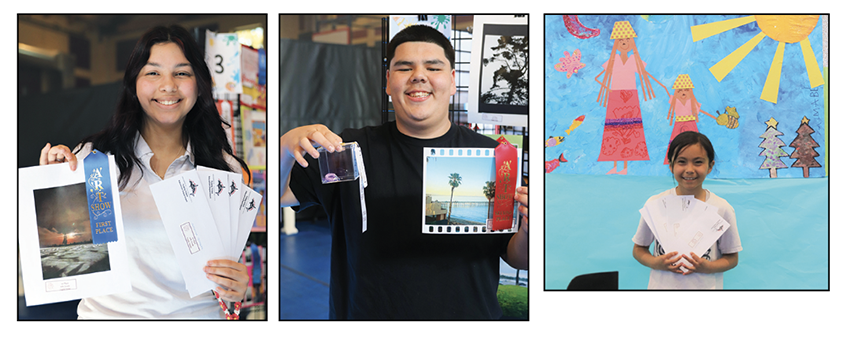
Such was the case with 9-year-old Tehya Robinson. She radiated pure joy while leading cousins and classmates to her five ribbon winning submissions. Then there was 13-year-old Gabe Joseph who beamed with pride as he posed for a picture with his 3rd place winning beaded earrings and 2nd place winning photograph.
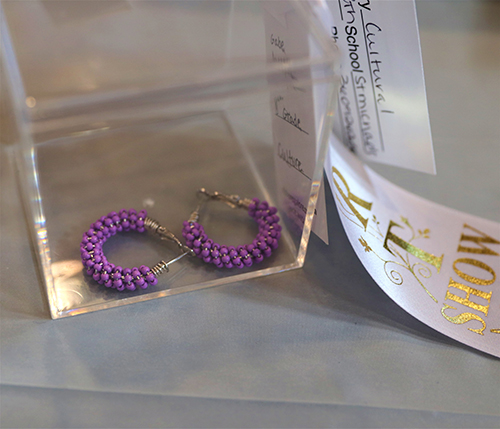
“The photograph I took was from a family vacation to California. I was standing on the balcony and thought the view was so cool that I needed to take a picture to remember it. The sun was just right and seeing the dock and palm trees just made me feel peaceful and relaxed,” shared the St. Michael’s 8th grader. “My aunt taught me to make beaded earrings and so I thought I’d make some purple ones to give to a friend’s mom. Now, she’ll be happy to know they are award winning earrings.”
Tehya, Gabe, and their fellow student culture bearers were able to win 1st, 2nd or 3rd place, plus honorable mention, in a variety of artistic mediums. Categories included culture, drawing, painting, writing, mixed media, sculpture, digital art, and pure heart. The top four from each grade and category received a ceremonial ribbon recognizing their talents and a monetary prize.

“It’s always amazing to see just how talented our Native students are. The new ideas and concepts they come up with every year continue to surprise us judges,” shared Festival judge Doug Salinas while admiring the middle school painting section. “I think every kid has the capability to be an artist because their imagination has no limits.”
Like in years past, this year’s Festival received hundreds of submissions, with the most popular category by far being painting. There were dozens of artists who showed off their diverse talents by submitting artwork in as many categories as they could. There are also artists who continue to evolve their artwork and challenge themselves each year to claim one of those coveted ribbons in different categories.
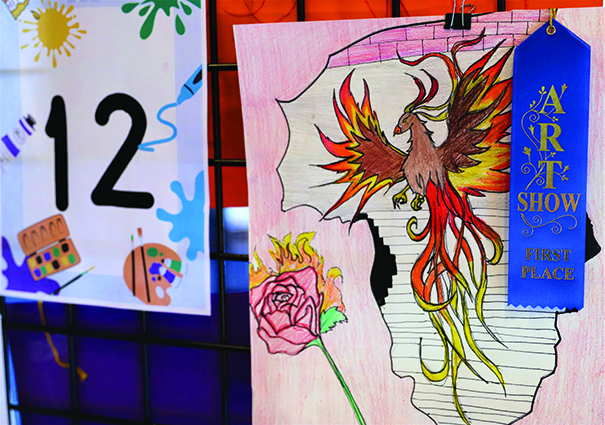
Tenth grader Catherine Velazquez is in the midst of quite the dynastic run, having won multiple ribbons since she first started participating in the Festival as an elementary-aged student. At 16-years-old now, she’s collected more ribbons than she can remember, but admits to looking forward to the Festival each year because of the opportunity to create new pieces and, yeah, collect some walking around money for her efforts.
“This past winter, I was at snow retreat in the mountains, it was night, the ground was completely covered in snow, and the moon casting this stunning red light. The moment was perfect for a picture. That photo won me 1st place this year,” said the Grace Academy 10th grader. She added ribbons from Digital Media, Mixed Media, Drawing, and Writing to her already large ribbon collection from past Festivals. “I love coming year each year and looking at all the art everyone does. Just walking around and admiring pieces that are my favorite inspires me to try new concepts and styles.”
This year’s art fest gala again offered several interactive tables, each led by an established adult artist. Representing possible career paths for the children to aspire to, or simply to have the young ones recognize art doesn’t have to stop when student life does. Tony Hatch, Tillie Jones, Ty Juvinel, and others did their best to engage Festival visitors and impart their cultural know-how through friendly, hands-on instruction.
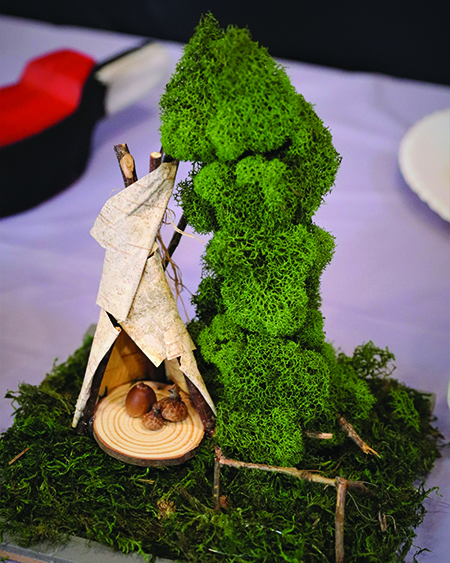
Pure heart icon Sean-Paul Mace was on-site with his very own table to display his LEGO Star Wars collection. He dazzled with his depths of dark side knowledge and could even tell you which cinematic scenes his figures could be found in.
Interwoven through many of the thought-provoking youth creations were both subtle and not so subtle tie-ins to ongoing social awareness campaigns, human rights issues and demands for a sustainable future. From artistic renditions on the Missing and Murdered Indigenous Women’s crisis, to declarations of Native-inspired rally cries like ‘Water Is Life’ and ‘Protect the Salmon’, to even rather imaginative way to represent heritage through a Fabergé egg.
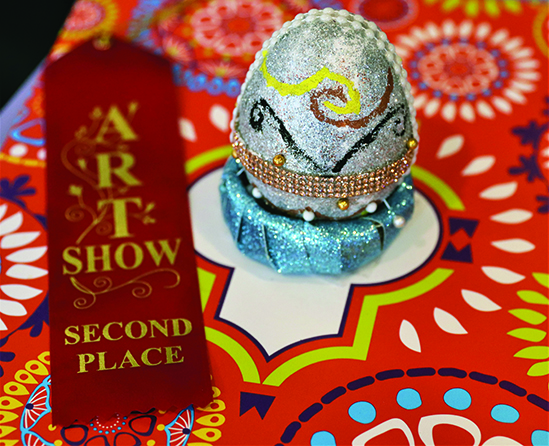
Fifth grader Lillianna Hope was gracious enough to break down the various elements of her heritage egg. “I chose copper as the equator line because is the closest color to yellow and yellow represents happiness. I chose to the eternal line because evil spirits will look at them and memorized by them and it will trap the evil spirit and it will stay in there forever. I did yellow dots because they represent happy memories. I chose the brown, yellow, and black swirls because I think it is pretty.”
Whether it was from reading written words or interpreting the depths of color and images on display from the inspiring artists, a message being conveyed loud and clear is that yes, in fact, the youngest among us are paying attention to current events and understand how their culture is viewed, both locally and nationally. More importantly, their art demonstrates they are capable of channeling their traditional teachings and spiritual strength into pure artistry.
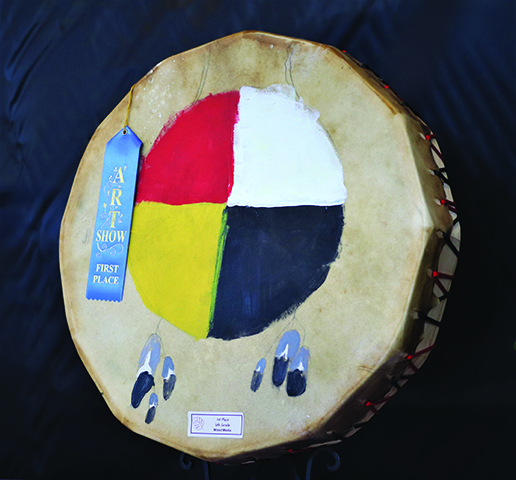
“When our kids create artwork for this event they are able to mix in elements of their personality, culture, family values, and what matters to them as individuals. It’s really incredible to see how even when there are twenty entries of the same type, each is different and unique in its own way because they reflect the artist who created it,” reflected Courtney Jefferson, Positive Youth Development Manager.
“Witnessing our kids get inspired from cultural pillars and advocacy movements is nice to see because that means they are learning about these foundational teachings while in school and retaining the information,” she added. “This proves how powerful it is to educate our people about our shared culture. Especially for the elementary-aged children. It’s so important they learn about the legacy of those who came before us and made it possible for us to thrive today.”
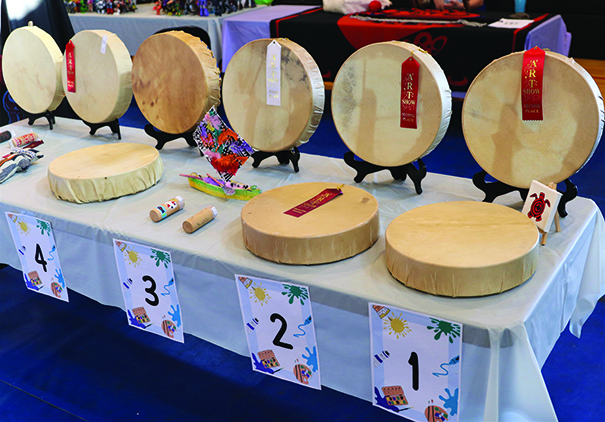
Without a doubt, the 2024 Native American Art Festival showcased a wide-range of artistic skills among our Tulalip youth. Confirming, yet again, what inspiring imaginations these artists are capable of creating when empowered to express themselves wholeheartedly and authentically, without judgement. Well, unless that judging comes with a shiny ribbon. Then it’s cool.
IndigipopX 2024 was a SMASH!
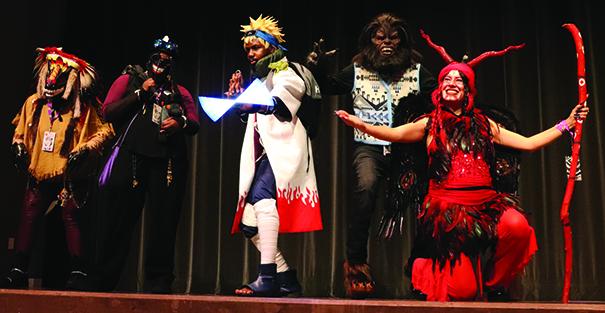
By Kalvin Valdillez, Tulalip News
Once upon a time in the 80’s, a giant wearing a sailor’s cap terrorized the streets of New York while wearing a bright smile on his face. In the classic 1984 Ghostbusters scene, people are seen abandoning their cars and running away from his path of destruction. 40 years later, the sight of the Stay Puft Marshmallow Man caused nothing but excitement as hundreds rushed toward the 30ft inflatable monster throughout the weekend of April 12, for their first photo-op at the 2024 IndigiPopX conference.
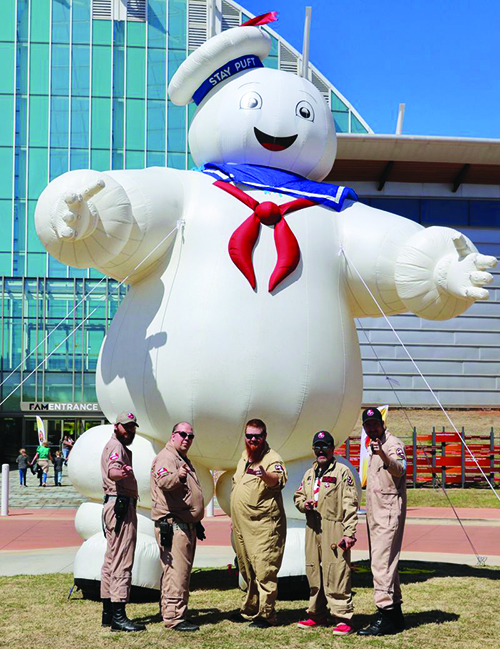
Now, that’s something you don’t see every day, but luckily for Indiginerds across the nation, this event does happen once a year. Back in 2016, this gathering of comic book and Indigenous pop culture fans made its debut in Albuquerque, New Mexico. Since then, it has grown and has become a space for Natives, in all creative mediums, to share in each other’s love for the geek culture and fandom.
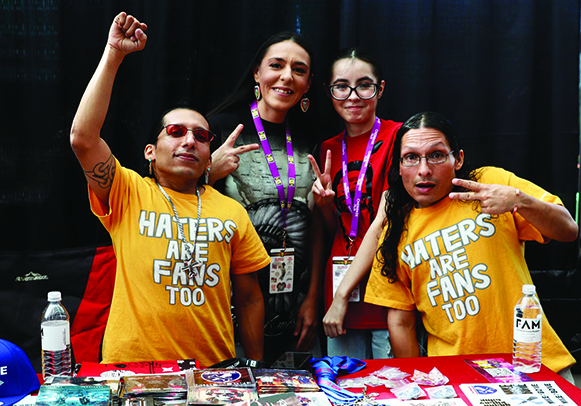
Formally known as Indigenous Comicon (ICON), the 3-day festival officially became IndigiPopX in 2019. Shortly after, the event found a permanent home at the First Americans Museum, in Oklahoma City, which features a large convention area with two theaters and plenty of space to host multiple workshops, panels, and live demonstrations throughout the weekend.
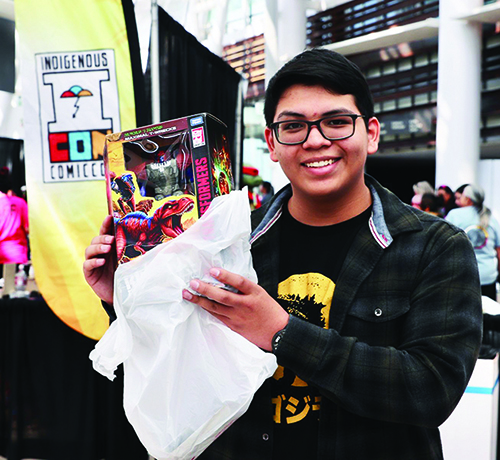
What makes IndigiPopX more exciting is they bring in accomplished creatives to share the tricks of their trade to help empower and inspire young and upcoming artists, writers, musicians, actors, social media influencers, and more. This year’s special guests included writers such as Shane Hawk, Johnnie Jae, Jim Terry, and F. Anthony Falcon. As well as several cast members from both Reservation Dogs and Echo.
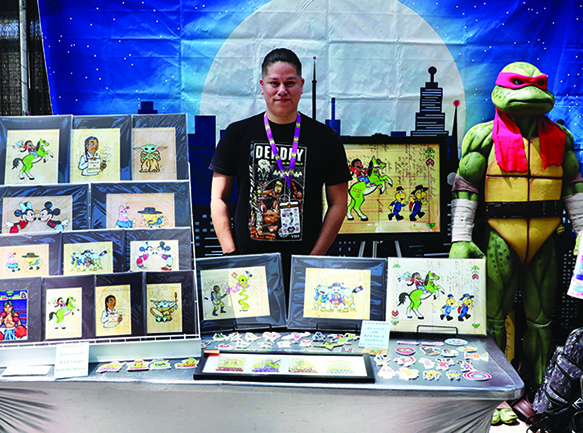
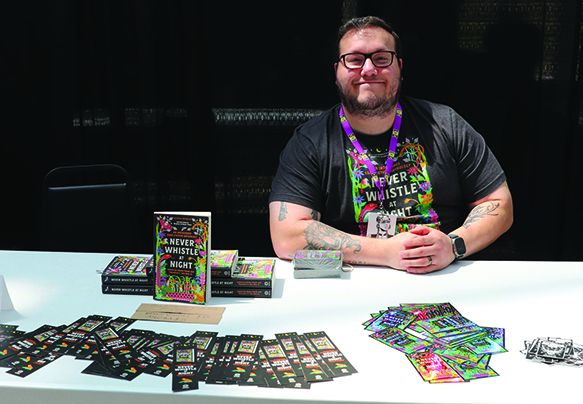
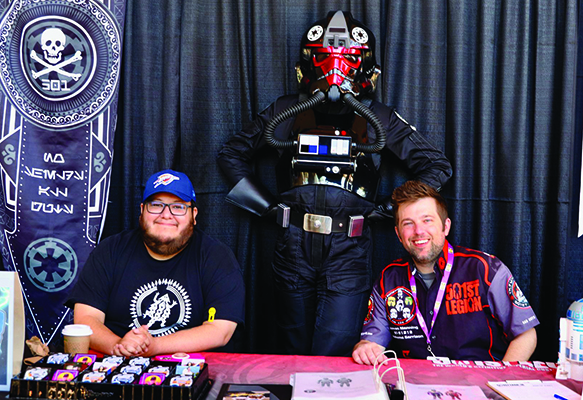
Author and Comic Book Writer, F. Anthony Falcon, shared his secret 5-step formula for writing fiction. With a packed classroom, he had each person in attendance write a summary of their very own story starting with 1. The protagonist 2. The antagonist 3. Their supporting characters 4. The journey and 5. A strong entity to open or close. By the end of the class, each writer had carved out a detailed idea for a story, and many were impressed to see their wildest imaginations come to life on paper.
Said Falcon, “To take part in this event and be able to share, it makes my heart happy. It makes me proud to know that I’m doing my little part to ensure that stories are being told and that our people feel valued. And it’s important that people understand – don’t let your voice go unnoticed, you’re special, you’re strong, and you do have it in you. If you want to be a writer, and you have a story to tell, by all means tell it. The goal of every Indigenous writer should be to elevate where they come from and their people, because that’s what you’re supposed to do. Don’t be afraid. Put that pen to paper or do it on your computer. Even if you’re only writing a couple sentences a night, you’re making progress and just know you’re valued, you’re important and your stories need to be heard.”
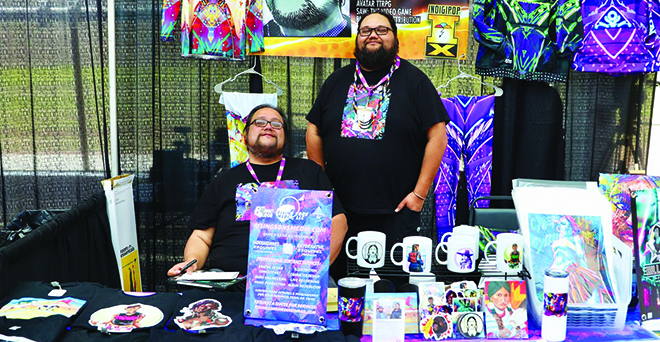
Also in attendance was an independent multi-media company that is making soundwaves here in the Pacific Northwest. Rising Sons Media, based out of Seattle, was started by the Esquivel brothers, Sade and Deyo (Kanien’keha:ke), who specialize in illustration, beadwork, and music production. Both Sade and Deyo hosted workshops throughout the weekend; Sade shared about his work that has been featured in video games and comic books, and Deyo hosted an interactive music production demonstration where he made a beat with those in attendance of his class. Through Rising Sons Media, Deyo has collaborated with other Native artists throughout our region. And recently, he produced and released an album by Tacoma Indigenous songstress, Akaya the Alien.

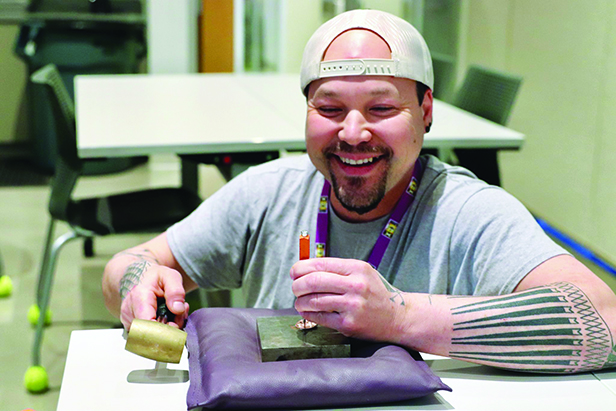
Following the workshop, Deyo shared, “One great thing about IndigiPopX is that we have so many Native people doing all these different things in art, music, film, VR, AI stuff, robotics. That’s a great thing to show the youth, all the different things that we can do and the different avenues that are there for us to be creative, and to tell our own stories – our cultural stories, our history, and our future. It’s not just about the past, the traditional ways the traditional songs, it’s about where do we go from here? How do we as modern people identify what is cultural for ourselves and for our future generations? And so that’s what I love about being here at IPX and teaching classes to the youth. Just to show that this is what you can do. You can do the art that you want, and it is Indigenous. Even if it’s hip-hop or it’s country, it’s Indigenous because it comes from you.”
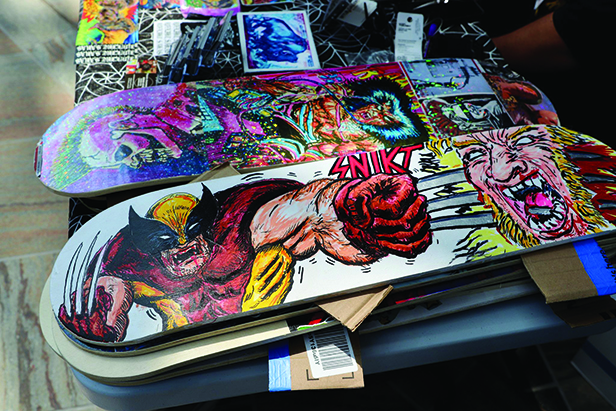
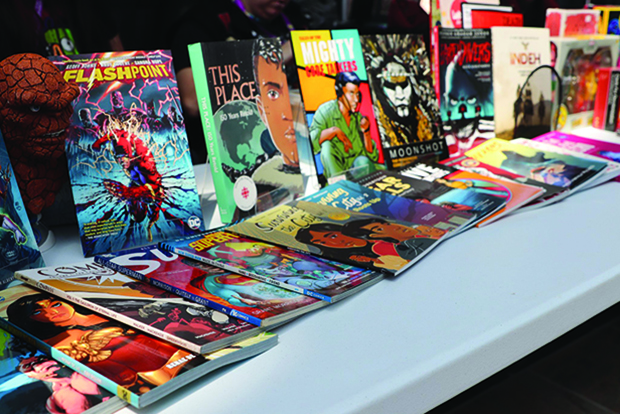
A major highlight for IndigiPopX goers is checking out all the artwork, clothing, jewelry, board games, stickers, and books that are on sale. What makes this special is the people get the chance to chat with the various creators and vendors, and more often than not, they leave with an autograph in addition to their purchase.
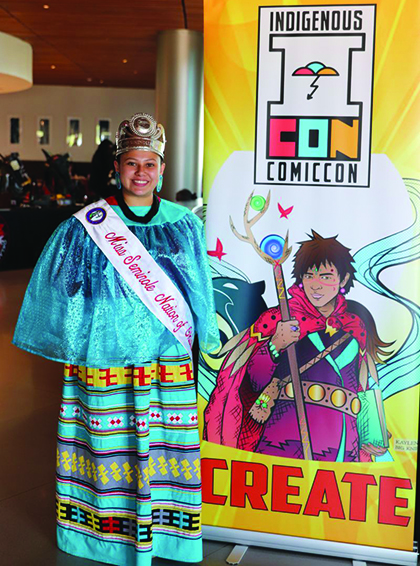
Comic book writer and First Nations artist, Alina Pete, made the trip to OKC from Vancouver, B.C. Amongst her jewelry and amazing Pokémon art prints, Alina had a number of her own comic books for sale. During the IndigiPopX weekend, the Native comic book community lost one of the founders of the Indiginerd culture, Jeffrey Veregge, who was known for bringing Coast Salish formline to the masses through his work with Marvel. While taking a moment to reflect on Jeffrey’s impact to the Native geek world, Alina shared that her book actually contains one of his last stories, By the light of the Moon.
“The main thing that I’m here promoting is my book, Woman in the Woods and other North American stories, which is a comic anthology by Iron Circus Comics,” said Alina. “It’s got a variety of stories in it from different Native groups around the USA and Canada. One of the stories in here is by an Indigenous comic artist we just lost this weekend, Jeffrey Veregge. He wrote it and he was slated to illustrate it, and he got sick during the course of it. So, his partner actually had to go onto his computer and find the script so that we could try and find someone to draw it and get it in the book, because we really wanted to include it in the book. And this was before – we didn’t know how serious it was yet. We thought he’ll recover, we’ll get his story in there, and he’ll go on to make so many more things. And it ended up being, I think, the last thing he worked on. I hope we made him proud.”
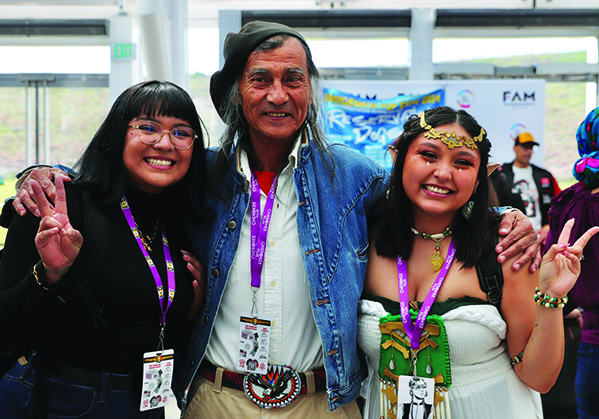
She continued, “I was just talking with a bunch of other friends who are also Indigenous comic artists who are here at the event. And we were saying how, most the time, when we were at comic book shows, we feel like we’re the only ones in the building. And so, we kind of have to explain what is Indigenous comics, and why are you doing it, and why is it important as an Indigenous person to do comics? And here, everyone just gets it. Everyone is like, yes, of course, Indigenous representation is really important. And that’s why we’re here, we just feel really loved and supported being here. But also, everyone gets what we’re trying to do, and why it’s so important to see yourself represented on the page of a comic book.”
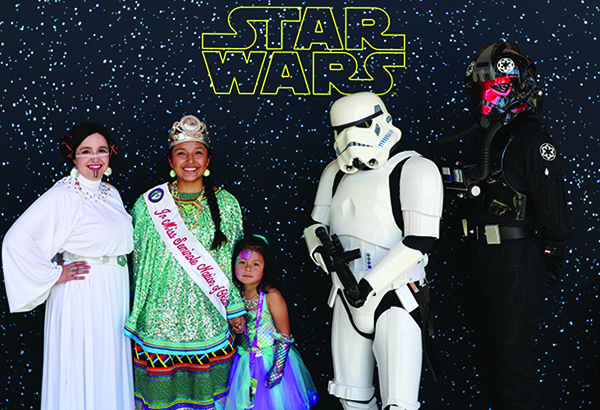
After a fun and geeked out weekend, IndigiPopX 2024 closed out with a cosplay contest in which nearly 30 participants showcased their tailoring skills on costumes that ranged in characters from Star Wars all the way to a Werewolf tribal chairman. Immediately after the contest winners were awarded their prizes, the cosplayers lined up for a parade around the First Americans Museum, before everyone said their goodbyes til next years conference.
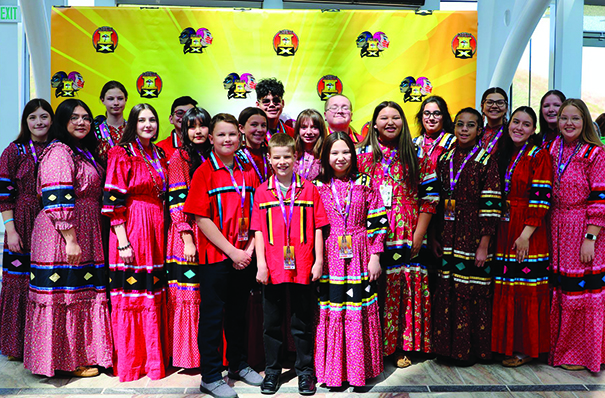
Indigenous artist and Cosplayer, Adam Youngbear, expressed, “I think it’s really awesome, just to have the opportunity to share my art, share my culture, but also see everybody else’s coming in, see the folks that are from up north or out west. So, I really think it’s awesome to get a blend of all the Native nerds together. I participated in the costume contest; I was a tribal council-wolfman. Last year, I was a Native ninja turtle and I got second place. My daughter won; she beat me last year. But it’s always fun to put a costume on and put a Native spin on it. It’s important to see that Native representation. We’re not only looking at movies and shows anymore, but we’re also seeing us in comics and gaming out. It’s really awesome to see that, the little kid in us is loving every second of it.”
Happy Earth Day!
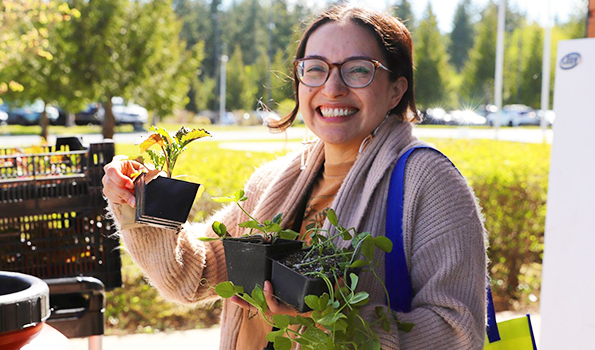
By Kalvin Valdillez, Tulalip News
This Earth Day, the Tulalip Tribes Natural Resources Department planned a full day of activities focused on community clean up and environmental restoration.
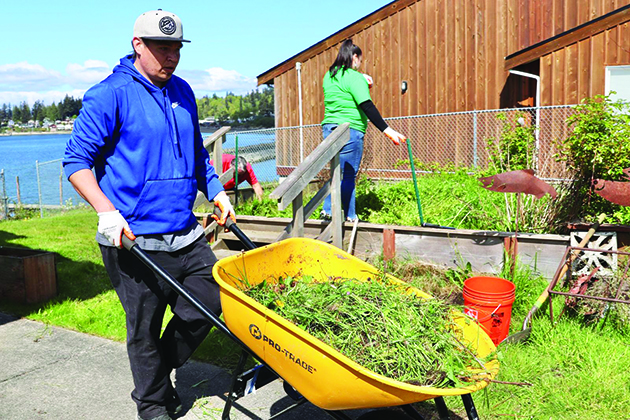
Multiple departments, students from both Heritage High and Quil Ceda Tulalip Elementary, tribal employees, and a few local businesses and non-profit organizations volunteered their time to the cause on the morning of April 22.
The Tribe hopes that this Earth Day gathering will serve as the kick-off event that will get the community more involved in their upcoming projects and events that are aimed at taking care of Mother Earth.
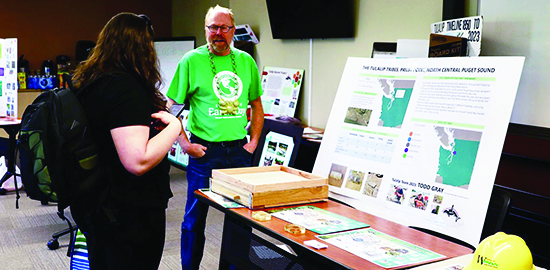
Said Melissa Gobin, Environmental and Education Outreach Coordinator, “I noticed there was a need for this and there are people wanting to do this work. We don’t want it to be just Earth Day, we want it to continue on. I think it’s important for all of us to network together, so we have some opportunities for the public to come in and give back, and so people know what’s out there and what the Tulalip Tribes is doing in natural resources because it’s important.”

All told, dozens of volunteers helped collect trash on Mission Beach and along 27th Ave, while several others opted to tend to the garden beds of the Senior Center, the Tulalip Health Clinic, and Quil Ceda Tulalip Elementary.
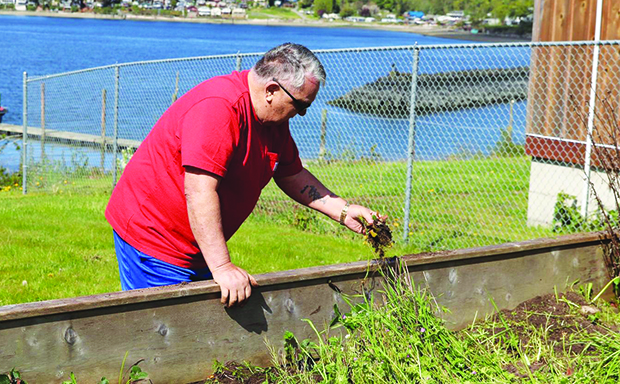
If you are interested in volunteer work to help combat pollution and preserve our natural world, keep an eye out for future events planned by the Tribes Natural Resources team as they plan on hosting many more get togethers throughout the year.
Salmon habitat restoration underway at Quil Ceda Creek
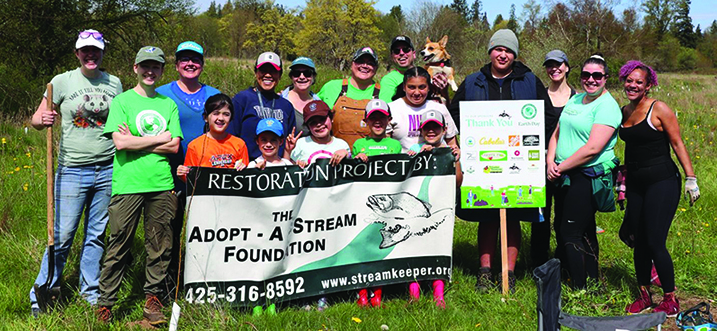
By Wade Sheldon, Tulalip News
With shovels in hands and the desire for a brighter future, not just for our community but also for the precious wildlife like the salmon, the Tulalip Tribes, in coordination with Adopt a Stream, hosted a tree planting event on Saturday, April 20, along Quil Ceda Creek. A celebration of Earth Day, nearly 100 people united for the finishing touches on this vital project to preserve salmon runs and combat global warming, locally.
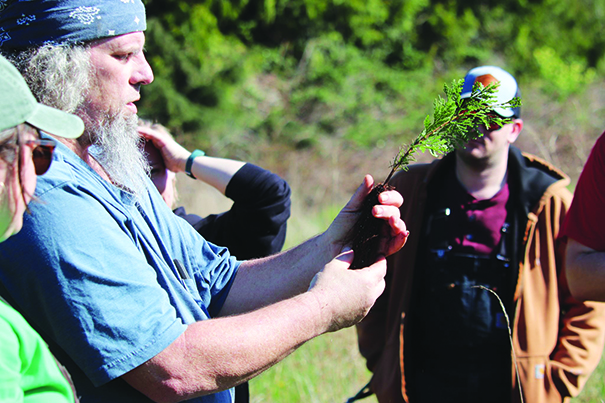
By creating shade along the creek, Tulalip hopes to counteract rising temperatures caused by global warming. With thousands of trees now planted, the goal is that 85% will thrive, helping maintain cooler water temperatures in the stream. This is crucial for the salmon habitat, as the trees will cover a little over a quarter mile of stream after their growth. This will ensure a lower temperature in the stream, a critical factor in keeping the fish healthy and thriving for years to come, thus preserving the salmon population.
Quil Ceda Creek was in such poor condition that it was listed as impaired or threatened waters under the 303(d) list, a water quality assessment conducted by the Department of Ecology every two years. This provided an opportunity for the tribe to obtain a 319 grant from the Department of Ecology. The 319 grants, a crucial part of the Clean Water Act, provide funding to state and tribal agencies to improve various waterways. In this case, the grant allowed the tribe to receive substantial financial support to restore the creek. The funds were used to remove all invasive species and plant trees on both sides of the creek, up to a distance of 100 feet, a significant step towards restoring the creek’s ecosystem.
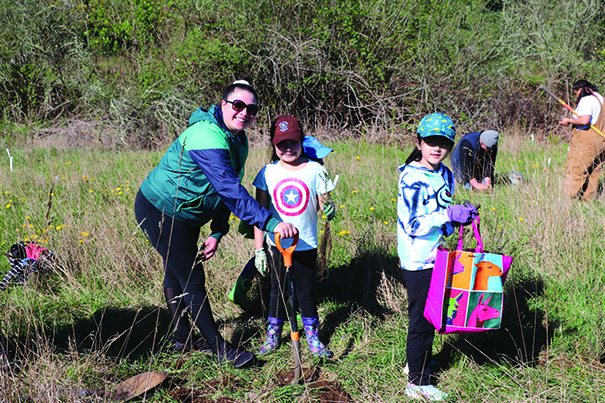
“We received the grant about three years ago,” said Walter Rung, Adopt a Stream fish and wildlife habitat program manager. “Since then, we have had to do a lot of work to get it to where it is today. The main focus has been on providing shade to keep the water cool. Our summers seem to have been getting drier and hotter, so the shade these plants create will help combat that. If the water temperature goes above 68 degrees, it becomes lethal for the salmon, and it’s getting close to that temperature. When you look at the site, you’ll see that there are no native plants or shade, so this will be a great thing for the stream.”
Volunteers of all ages, including members of the Tulalip Tribes and local residents, gathered along the banks of Quil Ceda Creek, eager to contribute to the restoration efforts. With each tree planted, a sense of hope and determination filled the air as community members worked hand in hand to protect the ecosystem they hold dear. Their dedication reflects a shared commitment to preserving the creek’s natural beauty and safeguarding its inhabitants for future generations.
“I came to help plant trees for Earth Day,” Tulalip tribal youth JoyAnn Rose Higginbotham said. “This will help shade the stream for the salmon and provide the three c’s: cold, clean, and clear. This will help ensure me and my people can enjoy salmon for the future.”
Awakening the canoes
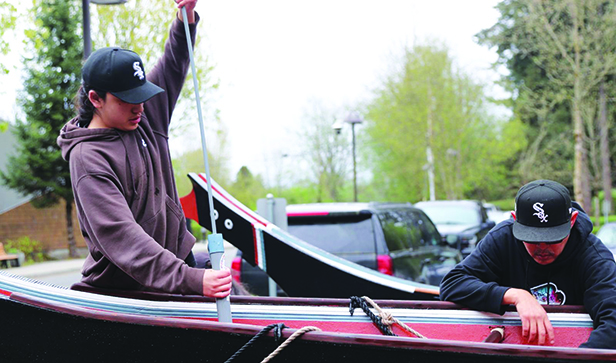
By Wade Sheldon, Tulalip News
On Monday, April 15, the Tulalip Canoe Family gathered at the Hibulb Cultural Center for the awakening ceremony. This ceremony, a significant part of our cultural tradition, involves washing the canoes in preparation for the upcoming season on the water. The tradition of waking the canoes has been practiced since the revamp of the canoe journey back in 1989 for the Paddle to Seattle. The canoe family relies on the canoe for protection and stability on the water, so they treat it with honor and respect. By doing so, the canoe will keep the riders safe and secure during their journeys.
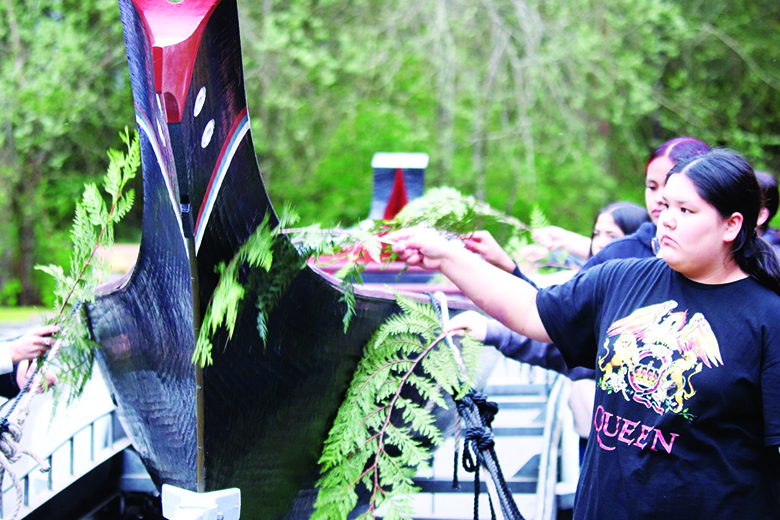
Taylor Henry, a respected member of the canoe family, took the lead in the ceremony. He encouraged the younger ones to participate, advising them to pick up a cedar bow and to think good thoughts while walking around and blessing the canoes. Passing down the tradition to the next generation is a crucial part of the ceremony, ensuring its continuity and preserving the canoe family’s cultural practices.
“We do this every year to wake up the canoes to let them know we are going to start to take them out on the water, Henry said. “We want to take care of the canoes so that they can take care of us. It’s been a long winter, and the canoes have been stored safely; washing the canoes as a community gives the people a chance to come together and start building for a new season on the water.
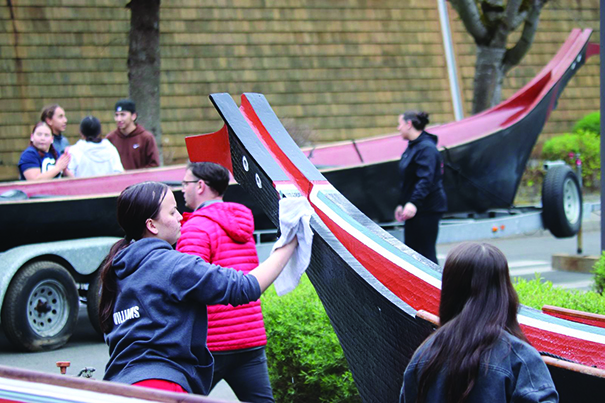
Each year, many new faces join the canoe family. One of the latest members, Elizabeth Williams-Juneau, shared, “This is my first year being a part of the canoe family. It’s an amazing experience because I didn’t grow up learning these teachings. I’m excited to be here, take in new experiences, and be a part of my culture.”
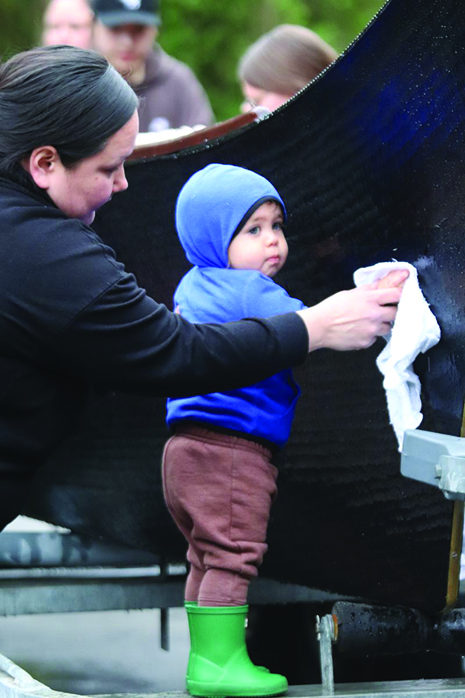
Gathered with purpose, the Tulalip Canoe Family came together to awaken their vessels, renewing their bond with tradition and each other. Their determination remained unwavering as they prepared for the season, finding strength in their shared heritage and the promises of safe travels on the water.
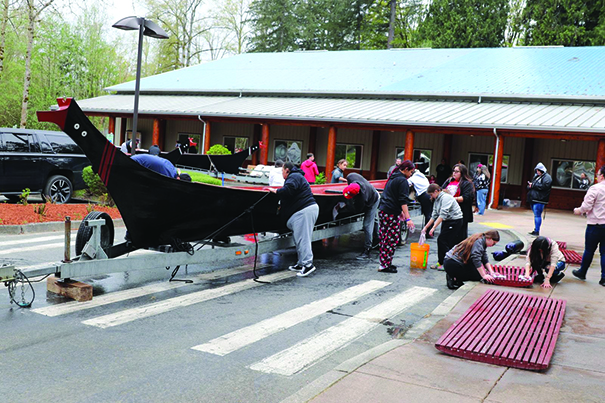
If you would like to get more involved or participate, the Tulalip Canoe Family will have practice every Wednesday at 5:30 at the Tulalip Marina. For more information, contact Andrew Gobin at (425) 244 7958.
In Loving Memory of Jenzele Couassi
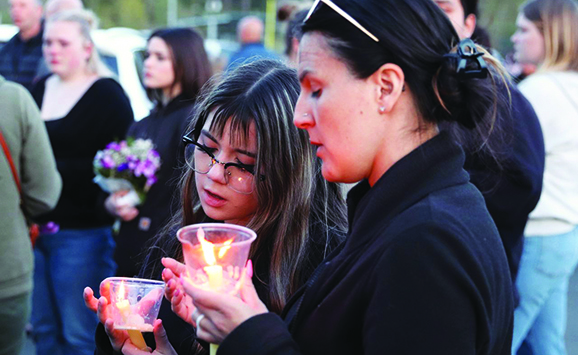
By Kalvin Valdillez, Tulalip News
Family and friends of Jenzele Couassi gathered for a prayer vigil on the night of April 22. This was just hours after her loved ones were delivered the unfortunate news that her body was discovered near the Tulalip teen center after she was reported missing over the weekend.
Her classmates, and many people she knew from both the Tulalip and Marysville communities were present at the vigil to not only shower her family with love, support, and prayers, but also to share about the person Jenzele was, their relationship to her, and the love they have for her.
It was a heartbreaking night, but Tulalip culture bearers did their best to let Jenzele’s parents and her brother know they are not alone. They encouraged all of her loved ones to lean upon their shoulders through this difficult time.
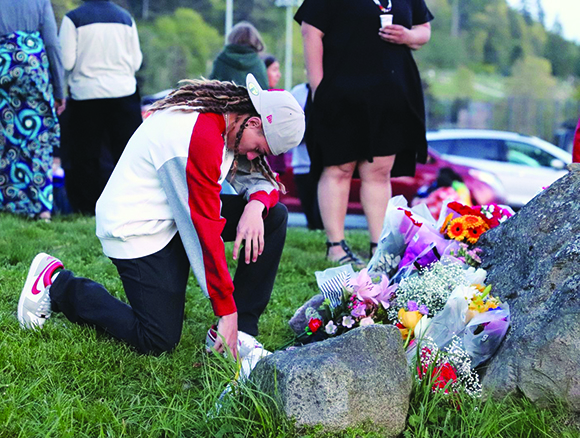
While many reflected on the light which Jenzele emanated, an eagle soared above the vigil and made a pass over the bay before it perched on a nearby tree and shared a song. This moment brought a bit of comfort to the family. Tulalip drummers and singers then sang the powerful and emotional song, Fly Eagle Fly, which was composed by the Antone George (Lummi).
An important message that tribal leaders and Marysville School District faculty shared with the youth was to reach out to their peers and community for help whenever they are struggling, and they also urged them to be there for each other in their times of need.
Said Tony Hatch, who guided the vigil and spoke on behalf of the parents, “I’m really happy to see that so many people showed up for the family. It’s overwhelming for the parents, but on the other side, they get to see the amount of love that their daughter brought to this community. And they get to experience that togetherness, to know they’re not alone; we’re with them all the way through. It breaks my heart that this is something that our kids get really good at – these type of candlelight vigils. And the reason why they’re good at it is because they’ve had to put away so many of their friends that they’ve went to school with.
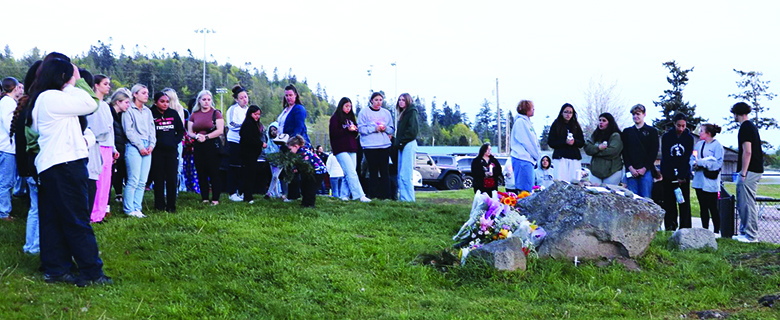
“We always hope and pray that they learn something from it; that they learn how to get along, how to be together and not beat on each other. Randy Vendiola said it great tonight – the best counselors out there for our kids are other kids. Kids want to talk to people their own age more than they want to talk to an adult sometimes. And as adults, we need to keep hammering away and getting them to open up when the times are tough. So, they know that it’s not the end of the world when something bad happens. Again, my heart breaks for her family. I hope they reach out to us for help with anything they need. I really hope they do.”
Our deepest condolences to Jenzele’s family and friends. If you or a loved one is struggling with mental health issues, you can call 988 for free confidential support 24hrs a day.
Joanne Little Deer Robinson-Velazquez
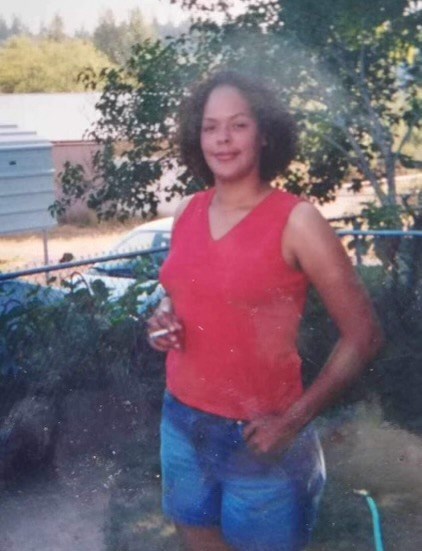
AUGUST 14, 1978 – APRIL 8, 2024
JoAnne Little Deer Robinson-Velazquez was born on August 14th 1978, she left us on April 8th 2024 to be with our Heavenly Father and Lord and Savior Jesus.
JoAnne came from a blended family. She leaves behind her mother, Mary Williams-Jackson; 5 children Melina Velasquez-Robinson, Destiny Velasquez-Robinson, Carlos Amado Cortez-Robinson, Larissa Cortez-Robinson, Mary Dela Cruz-Robinson. Her 2 grandchildren Rosalie Rita Torres-Velasquez and Miguel Torres-Velasquez. Siblings Elishia Stewart, Kenneth (Jessica) Robinson, Cassandra Jones, Shawn Jones, Demitri Jones-Robinson, Staycee Robinson and Maria Williams.
A celebration of her life will be held Friday, April 19, 2024 at 10 AM at the Tulalip Gathering Hall with burial to follow at Mission Beach Cemetery.
April 20, 2024 syəcəb
Use the following link to download the April 20, 2024 issue of the syəcəb
Legends never die: Jeffrey Veregge’s legacy lives on in his formline superheroes
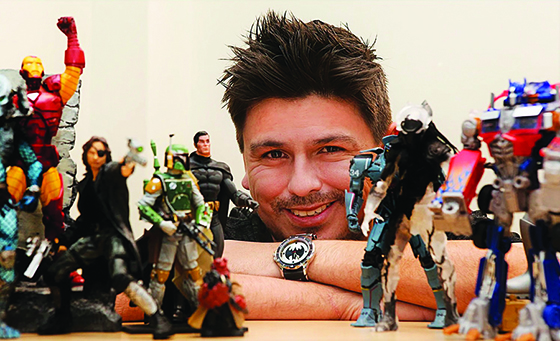
By Micheal Rios, Tulalip News
After three years of constant hospitalization due to acute renal and respiratory failure caused by undiagnosed lupus, acclaimed artist Jeffrey Veregge passed away on Friday, April 12, following a heart attack. He was 50 years old. He is survived by his wife Christina and their three children.
Following his passing, Christina posted on their shared Facebook account, “We’re heartbroken to share the devastating news that our beloved Jeffrey passed away, unexpectedly, this morning from a heart attack. Our family is in shock and trying to process this unimaginable pain. For 1,025 days he fought lupus like the superhero we knew him to be. The strength, determination and courage he showed while being in the hospital for a total of 925 days was an inspiration to us all. He will be missed more than words can express. This world was a better place because of him.”
A proud member of the Port Gamble S’Klallam Tribe, Jeffrey will be remembered for the remarkable imprint he made on lovers of comic books, action figures, and all things superhero related through his unmistakable, formline reimagining of iconic Marvel and DC characters.
As a Tulalip News reporter, I’m so grateful to have had two opportunities to interview and profile the self-described Salish Geek, first in 2015 at PechaKucha Seattle volume 63 and again in 2020 after his Native American heritage collaboration with Marvel Comics. Using the best parts of those previous interviews, I now share with our readers a profile on the man, the myth, the legend, Jeffery Veregge.
________________________________________
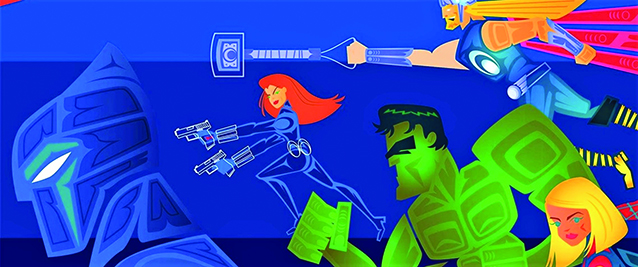
Jeffrey Veregge is an award winning Native American comic book artist from the Port Gamble S’Klallam Tribe, located in Kingston, Washington. His work uses Coastal Salish and contemporary graphic design techniques that created the look dubbed ‘Salish Geek’ by his creative peers. Along with his work for IDW Publishing, he has appeared in numerous websites and publications such as Fast Company Magazine, Cowboys and Indians, and Wired Magazine. His works and commissions are part of some prestigious collections located at Yale University, Washington State University, The Burke Museum and the Seattle Art Museum. He’s also the pop and nerd culture contributor for Indian Country Today Media, where he is known as NDN Geek.
“I was raised and spent a majority of my life on our Port Gamble reservation known locally as Little Boston. Although I am enrolled there, I am also both of Suquamish and Duwamish ancestry,” said Veregge of his Native American roots. “I am an honor graduate from the Art Institute of Seattle, and I have had the privilege to study with Tsimshian master carver David Boxley for a short time, learning the basics of Salish formline design.”
Veregge has been an artist since the moment he was able to hold his first action figure and created stories of his childhood superheroes on paper with whatever art utensils were available. That creative fire and passion for superheroes and comics never faded and eventually led him to the Seattle Art Institute where he studied industrial design technology. Later, he was fortunate to study with Boxley to learn Salish formline design, a traditional style that he would blend fluidly within the Marvel and DC universes
“My most popular works are a reflection of a lifetime love affair with comic books, toys, TV and film; taking my passions and blending them with my Native perspective,” he said.
After graduating from the Seattle Art Institute, Veregge had a great job at an advertising agency for eleven years. Working in advertising allowed him to tap into his creative side, but the Native artist within wasn’t satisfied, he needed something more. He went to art school to be an artist and to have fun, not to have his inner artist constrained by the everyday politics of advertising.
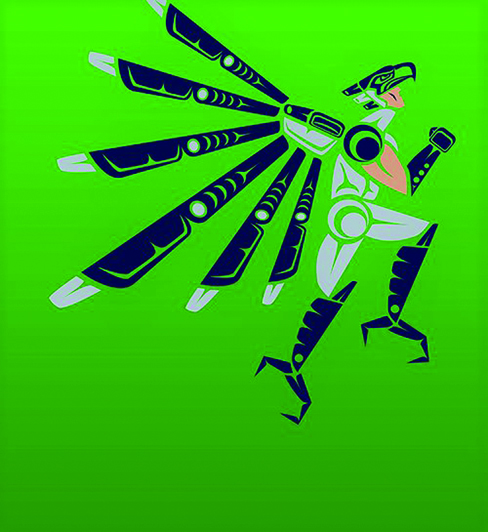
For him, being an artist wasn’t just to sell art and make money; it meant having fun, it meant viewing a blank piece of paper as a magical canvas to express the imagination of a cluttered mind of a Native American who loves comics, movies, Sci-Fi, and action figures. So, he left the advertising agency and embarked on an artist’s mission to create something truly unique. The search for a new, personal and bold direction in his work resulted in Veregge remixing iconic comic superheroes with his now highly tuned hand for formline.
“For me it wasn’t just trying to create art as a geek or nerd, but as a Native I felt like I had something unique to offer,” Veregge said. “That’s my appreciation for all art and design, my passion for heroes, robots, aliens and monsters, and my pride in where I came from.
“My origins are not supernatural, nor have they been enhanced by radioactive spiders. I am simply a Native American artist and writer whose creative mantra in best summed up with a word from my tribe’s own language: ταʔčαʔξʷéʔτəν, which means get into trouble.”
Following that mantra, constantly testing his creative boundaries, and, yeah, getting into trouble a time or two ultimately led Veregge to one solo exhibition opportunity after another to showcase the wonderful world inside the mind of a Salish Geek. Multiple exhibitions of his work were held from 2009 to 2020, the pinnacle of whish was the Smithsonian’s 2018-2020 show at the National Museum of the American Indian, Of Gods and Heroes, featuring two 50-foot murals of Marvel’s heroes battling the Celestials.
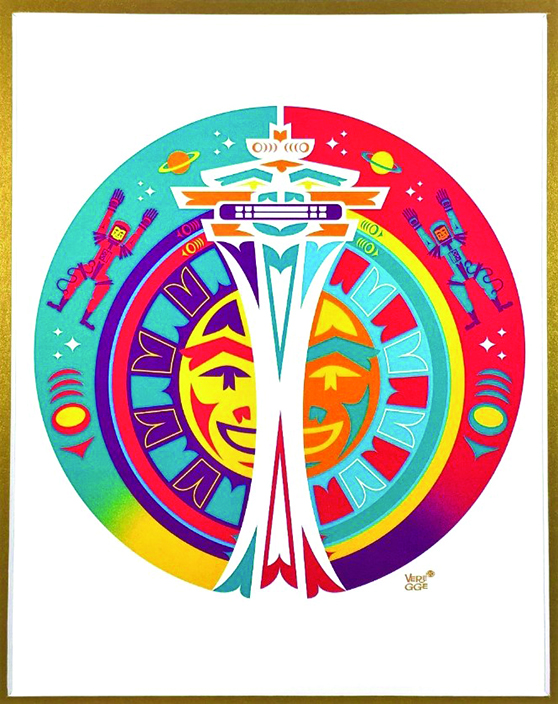
“For thousands of years, Native and non-Native storytellers have used art as a means to share the tales of their people. For me, I am carrying on a tradition that started with my ancestors by simply using the means of today and all its modern conveniences to share the tales that I love. Art evolves, tools get better, but the essence of what I do is the same as those who did it on the canvases nature provided for them to tell the stories of gods and heroes long, long ago” stated the Salish Geek on his website prior to Of Gods and Heroes grand opening.
His explosion onto the highest levels of the art scene eventually meant his one-a-kind designs reached the game-changing creatives at Marvel Comics. It was perfect timing, too, as the comic book goliath was in the midst of developing an all-new collection titled Marvel’s Voices.
“Marvel’s Voices started and evolved from a popular Marvel podcast into a larger program within our comics,” explained Marvel Comics Editor-in-Chief, C.B. Cebulski in a press release. “Our first anthology in this program was released this past February and the reception from fans was incredible. It was clear we needed to do more to lift up more voices and talent and increase representation in and behind our stories. This is the first step of our next expansion of the program to discover new writers and artists who can bring their voices to our characters, both old and new. And this is only the beginning.”
In a cosmic shift for Native American representation, Marvel celebrated Indigenous history in November 2020 with a landmark special, Indigenous Voices #1. Written and drawn by some of the industry’s most renowned Indigenous talent, including none other than the Salish Geek himself, Jeffrey Veregge. Now a celebrated artist, he is leading this super powered movement alongside a team of creators to explore the legacy and experiences of Marvel’s incredible cast of Indigenous characters.
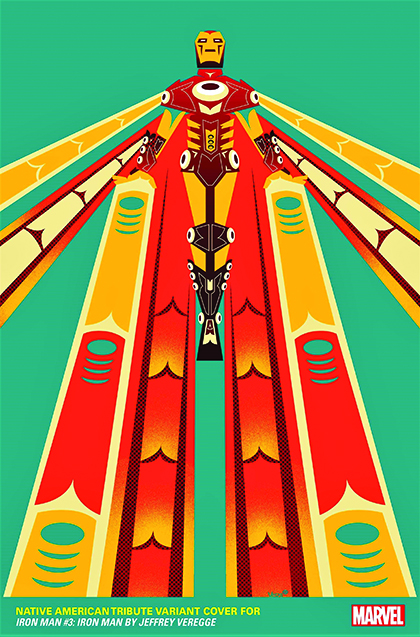
In addition to the Indigenous Voices comic series, Veregge illustrated Native American tribute variant covers for other popular comic titles featuring Dani Moonstar, Black Panther, Iron Man, Captain America, Hulk and others. All depicted in his signature Salish style.
“I am truly grateful for the platform that Marvel has not only provided for me and my work, but with this edition of Marvel Voices, all of Native America,” said Veregge. “This is an opportunity to share the cultural influences that we as Native artists and writers grew up with that will add more depth and dimension to the Native heroes in the Marvel Universe.”
From blockbuster movie goers, animated series streamers, and a very devout base of comic book enthusiasts, there are hundreds of millions of Marvel superhero fans globally. The exposure to the limited-edition Indigenous Voices series and the must-have Native Heritage tribute covers illustrated by Veregge offered immeasurable cross-cultural learning experiences to the traditional Native storytelling and the thriving art scene that is Salish formline.
In a world severely lacking in authentic representation of Native American culture, Veregge reached the highest pinnacle of his craft while elevating Salish formline into the bold and vibrant worlds of comic book lore and museum quality art exhibitions.
Within the pop culture realm, there’s a saying that goes something like “There’s heroes and there’s legends. Heroes get remembered, but legends never die.” The Salish Geek is a f*cking legend.